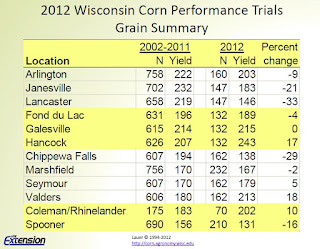Due to warmer than normal conditions during March, planting started quickly and then was delayed by wet conditions around May 1. Over the entire growing season, growing degree-day accumulation was above the 30-year normal. During May, June, and July, precipitation was significantly below average in southern Wisconsin, while northern Wisconsin had above-average precipitation. Drought conditions continued through August and September in the southern half of Wisconsin and were also observed in the northern half of the state. Due to a dry and relatively warm September and October, good grain drying occurred, with harvest grain moisture lower than normal in all trials. Test weight was above average for most locations. Little insect or disease pressure was observed in most trials. Fall weather conditions, although dry, were ideal for harvest and fall farm work.
 |
| Figure 1. U.S. drought monitor on July 17, 2012. Southern Wisconsin was hit with extreme drought that would not be relieved during the remainder of the growing season. |
Grain and silage yields were below the 10-year average at most sites (Tables 1 and 3). Locations that were significantly below the 10-year average included the southern zone (Arlington, Janesville, and Lancaster) and sites with sandy soils (Chippewa Falls and Spooner).
Even though production was below normal, grain yield was not as bad as 1988 (Table 2). Nearly every location was affected by drought, except for the irrigated site located at Hancock.
Record yields in spite of the drought
For grain performances over a zone (South central), the top yielding hybrid was G2 Genetics 5H-806 at 259 bu/A. For a location (Hancock), the top yielding hybrid, G2 Genetics 5H-0504, set the highest location record yield at 299 bu/A. In the South central zone, 8 of the top 10 hybrids set record yields for the zone. Fifteen hybrids broke into the All-time Top 50 list for a location. All were grown in the South Central production zone.
For silage performances over a zone (South central), the top yielding hybrid was Dairyland EXP-11302 at 11.3 T/A. For a location (Galesville), the top yielding hybrid was Dairyland EXP-11302 at 12.3 T/A. In the Northern zone, 8 of the top 10 hybrids set record yields for the zone.
For a complete report on commercial hybrids for corn production in Wisconsin see 2012 WISCONSIN CORN HYBRID PERFORMANCE TRIALS Grain - Silage - Specialty - Organic December 2012 A3653.



No comments:
Post a Comment